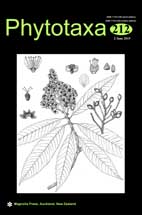Abstract
Pinnunavis edkuensis is reported as a new diatom species from Egypt from brackish and marine habitats. Its description and diagnoses focus on 12 continuous morphological characters: valve breadth, valve mantle shape and surface area, axial-central area shape and surface area, axial area breadth, distal and proximal interstriae distances, striae slopes, magnitude and position of maximal slope along a semivalve transect, and inter-raphe distance. These characters are considered along their ontogenetic trajectories, using a size vector, by means of regression analyses. Shape was assessed using geometric morphometric methods. Diagnostic comparisons of P. edkuensis were made with P. yarrensis, for which a lectotype was chosen and Grunow’s unpublished description and drawings presented, and P. zalatii, a new name replacing the illegitimate name, Navicula aegyptiaca. P. edkuensis was demonstrated to be a distinct group compared to these two similar species using 11 of the 12 characters. The diagnoses emphasize species recognition by means of anova, regression and randomization analyses and specimen determination primarily by means of regression-based prediction intervals. Additional comments are made on the statistical nature of gaps associated with characters described by discrete or continuous variables, the importance of reporting sample sizes as part of diatom diagnoses and other comparisons, and the role of size in specimen comparability and taxon identification. The generic distinctness of Pinnunavis and Pinnularia is discussed based on a preliminary cladistic analysis of morphological characters.

